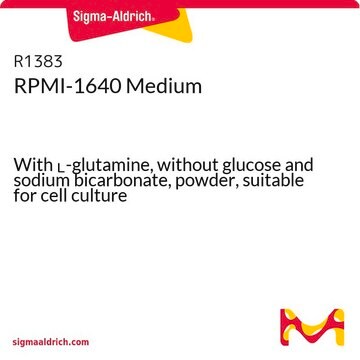D5030
Dulbecco′s Modified Eagle′s Medium
Without glucose, L-glutamine, phenol red, sodium pyruvate and sodium bicarbonate, powder, suitable for cell culture
Synonyme(s) :
DME, DMEM
About This Item
Produits recommandés
Niveau de qualité
Forme
powder
Technique(s)
cell culture | mammalian: suitable
Composants
phenol red: no
NaHCO3: no
L-glutamine: no
HEPES: no
glucose: no
sodium pyruvate: no
Conditions d'expédition
ambient
Température de stockage
2-8°C
Catégories apparentées
Description générale
Application
- to culture the isolated flexor digitorum brevis (FDB) fibers to measure exogenous fatty acid (FA) utilization as part of oxygen consumption rate (OCR) measurements
- to culture the isolated tibialis anterior (TA) muscle fibers for lactate measurements
- to culture the human bone marrow mesenchymal stem cells for osteogenic differentiation to prepare a low-glucose medium to culture human hepatocellular carcinoma HepG2 cells
Quantité
Reconstitution
Produit(s) apparenté(s)
Souvent commandé avec ce produit
Supplément
Mention d'avertissement
Warning
Mentions de danger
Conseils de prudence
Classification des risques
Eye Irrit. 2
Code de la classe de stockage
11 - Combustible Solids
Classe de danger pour l'eau (WGK)
WGK 3
Point d'éclair (°F)
Not applicable
Point d'éclair (°C)
Not applicable
Certificats d'analyse (COA)
Recherchez un Certificats d'analyse (COA) en saisissant le numéro de lot du produit. Les numéros de lot figurent sur l'étiquette du produit après les mots "Lot" ou "Batch".
Déjà en possession de ce produit ?
Retrouvez la documentation relative aux produits que vous avez récemment achetés dans la Bibliothèque de documents.
Les clients ont également consulté
Articles
Calcium is an ionically stable divalent cation with important beneficial and toxic properties in cell culture. It is a component of a wide range of cell culture media.
Protocoles
Cultrex® Basement Membrane Extract (BME) is a soluble form of basement membrane purified from Engelbreth-Holm-Swarm (EHS) tumor.
3-D Culture Matrix™ Mouse Laminin I may be used as a gel or as a media additive to study cellular growth and differentiation in three dimensions in vitro.
Contenu apparenté
Our broad range of the most trusted tools for cell culture includes stringently sourced and tested FBS, established media formulations, and sterile labware. Cutting-edge techniques using stem cells and 3D matrices are enabled by organoids, hydrogels, culture scaffolds, and bioinks for 3D bioprinting.
Notre équipe de scientifiques dispose d'une expérience dans tous les secteurs de la recherche, notamment en sciences de la vie, science des matériaux, synthèse chimique, chromatographie, analyse et dans de nombreux autres domaines..
Contacter notre Service technique







